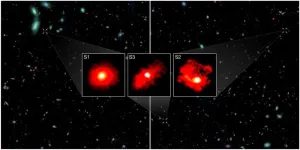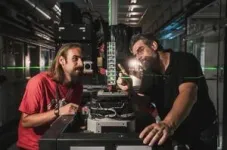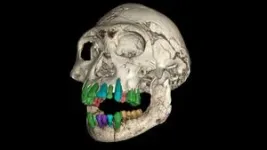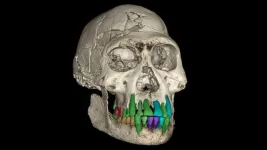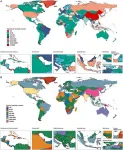(Press-News.org) An international team that was led by the University of Geneva (UNIGE) and includes Professor Stijn Wuyts from the University of Bath in the UK has identified three ultra-massive galaxies – each nearly as massive as the Milky Way – that had already assembled within the first billion years after the Big Bang.
The researchers’ results indicate that the formation of stars in the early Universe was far more efficient than previously thought, challenging existing galaxy formation models.
The surprising discovery – described today in the journal Nature – was made by the James Webb Space Telescope (JWST) as part of the JWST FRESCO programme.
The programme set out to systematically analyse a complete sample of emission-line galaxies (ELGs) within the first billion years of cosmic history. ELGs exhibit strong emission lines in their spectra (a spectrum is the range of different wavelengths of light emitted). These emission lines appear as bright lines at specific wavelengths, standing out against the darker background of the spectrum.
The presence of emission lines enabled the team to accurately pin down the distances to the galaxies in the sample. In turn, precise knowledge of the distances and emission line strengths allowed the researchers to reliably measure the amount of stars contained within the galaxies. Three stood out by their large stellar content.
“Finding three such massive beasts among the sample poses a tantalising puzzle”, said Professor Wuyts, co-author of the Nature study and Hiroko Sherwin Chair in Extragalactic Astronomy at Bath’s Department of Physics.
“Many processes in galaxy evolution have a tendency to introduce a rate-limiting step in how efficiently gas can convert into stars, yet somehow these Red Monsters appear to have swiftly evaded most of these hurdles.”
Fast growing Red Monsters
Until now, it was believed that all galaxies formed gradually within large halos of dark matter. Dark matter halos capture gas (atoms and molecules) into gravitationally bound structures. Typically, 20% of this gas, at most, is converted into stars in galaxies. However, the new findings challenge this view, revealing that massive galaxies in the early Universe may have grown far more rapidly and efficiently than previously thought.
Detail in the FRESCO study was captured through ‘slitless spectroscopy’ with JWST’s Near Infrared Camera, a surveying method that allows light to be captured and unravelled into its constituent wavelengths for all objects in a field of view. This makes it an excellent method for measuring accurate distances and physical characteristics of galaxies.
JWST's unparalleled capabilities have allowed astronomers to systematically study galaxies in the very distant and early Universe, providing insights into massive and dust-obscured galaxies. By analysing galaxies included in the FRESCO survey, scientists found that most galaxies fit existing models. However, they also found three surprisingly massive galaxies, with stellar masses comparable to today’s Milky Way.
These are forming stars nearly twice as efficiently as lower mass galaxies from the same epoch or ordinary galaxies at later times in cosmic history. Due to their high dust content, which gives these three massive galaxies a distinct red appearance in JWST images, they have been named the three Red Monsters.
Dr Mengyuan Xiao, lead author of the new study and postdoctoral researcher at UNIGE, said: “Our findings are reshaping our understanding of galaxy formation in the early Universe.”
Dr David Elbaz, director of research at CEA Paris-Saclay and collaborator on this project, said: “The massive properties of these Red Monsters were hardly determined before JWST, as they are optically invisible due to dust attenuation.”
A Milestone in Galaxy Observations
Pascal Oesch, associate professor in the Department of Astronomy at the UNIGE, and principal investigator of the observation programme, said: “Our findings highlight the remarkable power of NIRCam/grism spectroscopy. The instrument on board the space telescope allows us to identify and study the growth of galaxies over time, and to obtain a clearer picture of how stellar mass accumulates over the course of cosmic history.”
While these findings do not conflict with the standard cosmological model, they raise questions for galaxy formation theories, specifically the issue of ‘too many, too massive’ galaxies in the early Universe.
Current models may need to consider unique processes that allowed certain early massive galaxies to achieve such efficient star formation and thus form very rapidly, very early in the Universe. Future observations with JWST and the Atacama Large Millimeter Array (ALMA) telescope will provide further insights into these ultra-massive Red Monsters and reveal larger samples of such sources.
Dr Xiao said: “These results indicate that galaxies in the early Universe could form stars with unexpected efficiency. As we study these galaxies in more depth, they will offer new insights into the conditions that shaped the Universe’s earliest epochs. The Red Monsters are just the beginning of a new era in our exploration of the early Universe.”
Professor Wuyts added: "That is what is so great about astronomy, we're constantly being surprised by new discoveries. Already in its first few years of operation, JWST has thrown us a couple of curveballs. In more ways than one, it has shown us that some galaxies mature rapidly during the first chapters of cosmic history."
ENDS.
END
Astronomers discover mysterious ‘Red Monster’ galaxies in the early Universe
An international team that includes the University of Bath has discovered three ultra-massive galaxies (‘Red Monsters’) in the early Universe forming at unexpected speeds, challenging current models of galaxy formation.
2024-11-13
ELSE PRESS RELEASES FROM THIS DATE:
The secrets of fossil teeth revealed by the synchrotron: a long childhood is the prelude to the evolution of a large brain
2024-11-13
The secrets of fossil teeth revealed by the synchrotron: a long childhood is the prelude to the evolution of a large brain
Could social bonds be the key to human big brains? A study of the fossil teeth of early Homo from Georgia dating back 1.77 million years reveals, thanks to the European Synchrotron (ESRF) in Grenoble, a prolonged childhood despite a small brain and an adulthood comparable to that of the great apes. This discovery suggests that an extended childhood, combined with cultural transmission ...
Obesity-fighting drugs may reduce alcohol consumption in individuals with alcohol use disorder
2024-11-13
A new joint study by the University of Eastern Finland and Karolinska Institutet in Sweden found that the GLP-1 agonists semaglutide and liraglutide, which are used for treating diabetes and obesity, were associated with fewer hospitalisations among individuals with alcohol use disorder, AUD. Fewer hospitalisations were observed for alcohol related causes, substance use related causes, and for physical illnesses. However, no association was observed for hospitalisations due to attempted suicide.
Effective treatments for alcohol dependence exist; however, they remain underused and are not effective, or suitable, for all patients with alcohol or substance use disorder. Previous ...
Does AI improve doctors’ diagnoses? Study puts it to the test
2024-11-13
With hospitals already deploying artificial intelligence to improve patient care, a new study has found that using Chat GPT Plus does not significantly improve the accuracy of doctors’ diagnoses when compared with the use of usual resources.
The study, from UVA Health’s Andrew S. Parsons, MD, MPH and colleagues, enlisted 50 physicians in family medicine, internal medicine and emergency medicine to put Chat GPT Plus to the test. Half were randomly assigned to use Chat GPT Plus to diagnose complex cases, while the other half relied on conventional methods such as medical reference sites (for example, UpToDate©) and Google. The researchers then compared the resulting ...
Extreme weather accelerates nitrate pollution in groundwater
2024-11-13
Extreme weather spurred by climate change, including droughts and heavy rains, may increase the risk of nitrates from fertilizers ending up in groundwater, according to a recent study from researchers at the University of California, Davis. The study found heavy rains after a drought caused nitrates to seep 33 feet under farm fields in as little as 10 days. The study was published in Water Resources Research.
“The conventional wisdom was that it could take several weeks to years for nitrates to move from the crop root zones to reach groundwater,” said corresponding author Isaya Kisekka, a professor in the Departments ...
Burden of liver cancer attributable to hepatitis B and alcohol globally, in China, and for five sociodemographic index regions from 1990 to 2021
2024-11-13
Background and Aims
Liver cancer is a digestive system malignancy that poses a significant public health challenge globally. This study aimed to analyze and compare the epidemiological trends of liver cancer attributed to hepatitis B (LCHB) and alcohol use (LCAL) over the past 32 years.
Methods
Data on mortality and disability-adjusted life years for LCHB and LCAL in China, globally, and across five sociodemographic index regions were obtained from the Global Burden of Disease 2021 database and comprehensively ...
Lehigh partners with North Carolina A&T to enhance flood damage mapping with AI and advanced radar
2024-11-13
One only needs to glance at the news, social media, or even just out the window to understand the devastation caused by flooding. Recent back-to-back major hurricanes have brought catastrophic rainfall that has devastated communities across the southeastern United States.
With climate change, experts predict these extreme weather events will increasingly become the norm. Among the many ways that researchers are devising strategies to protect and assist vulnerable areas, one such effort involves increasing the speed and accuracy of damage assessments.
“Research ...
2024 AAAS Kavli Science Journalism Award winners named
2024-11-13
Stories on the discovery of vital fluid-transport systems in the human body are among the winners of the 2024 AAAS Kavli Science Journalism Awards. Winning journalists also did immersive stories on scientists and physicians at work – in the field, in the lab and in the emergency room.
Independent panels of science journalists select the winners of the awards, which are administered by the American Association for the Advancement of Science (AAAS) and endowed by The Kavli Foundation. There is a Gold Award ($5,000) and Silver Award ($3,500) for each of the eight categories. The global awards program drew entries ...
Collaborative of prominent academic institutions launches groundbreaking healthcare AI challenge
2024-11-13
Mass General Brigham AI is hosting the Healthcare AI Challenge, a multi-institutional virtual, interactive series of events where healthcare professionals can explore and assess the latest AI healthcare technologies in real-world healthcare scenarios.
The Healthcare AI Challenge Collaborative is launching with a diverse set of healthcare institutions and their healthcare professionals, including Mass General Brigham; Emory Healthcare; the Department of Radiology at the University of Wisconsin School of Medicine and Public Health; and the Department of Radiology at the University of Washington School of Medicine. The American College of Radiology (ACR), ...
American Federation for Aging Research announces 2024 AFAR grants for junior faculty
2024-11-13
NEW YORK, NY— The American Federation for Aging Research (AFAR) is pleased to announce the recipients of its 2024 AFAR Grants for Junior Faculty. The AFAR Grants for Junior Faculty program provides up to $150,000 for a one- to two-year award to junior faculty (MDs and PhDs) to conduct research that will serve as the basis for longer term research efforts on the biology of aging. The major goal of this program is to assist in the development of the careers of early career investigators committed to pursuing careers in aging research. Selected through ...
Potential single-dose smallpox and mpox vaccine moves forward
2024-11-13
Highlights:
An FDA-approved vaccine for smallpox and mpox is effective but causes side effects. The other requires multiple doses.
An experimental single-dose vaccine uses the horsepox virus to harness the benefits of both strategies.
Previous studies suggest that inoculation with horsepox elicits an antibody response to mpox and provides 100% protection in animal models.
New data show that the horsepox virus is significantly more attenuated, or weakened, compared to the virus used in the FDA-approved live virus vaccine.
Washington, D.C.—Vaccines that prevent smallpox and mpox come in 2 varieties. One uses a single shot of a live virus but ...
LAST 30 PRESS RELEASES:
Injectable breast ‘implant’ offers alternative to traditional surgeries
Neuroscientists devise formulas to measure multilingualism
New prostate cancer trial seeks to reduce toxicity without sacrificing efficacy
Geometry shapes life
A CRISPR screen reveals many previously unrecognized genes required for brain development and a new neurodevelopmental disorder
Hot flush treatment has anti-breast cancer activity, study finds
Securing AI systems against growing cybersecurity threats
Longest observation of an active solar region
Why nail-biting, procrastination and other self-sabotaging behaviors are rooted in survival instincts
Regional variations in mechanical properties of porcine leptomeninges
Artificial empathy in therapy and healthcare: advancements in interpersonal interaction technologies
Why some brains switch gears more efficiently than others
UVA’s Jundong Li wins ICDM’S 2025 Tao Li Award for data mining, machine learning
UVA’s low-power, high-performance computer power player Mircea Stan earns National Academy of Inventors fellowship
Not playing by the rules: USU researcher explores filamentous algae dynamics in rivers
Do our body clocks influence our risk of dementia?
Anthropologists offer new evidence of bipedalism in long-debated fossil discovery
Safer receipt paper from wood
Dosage-sensitive genes suggest no whole-genome duplications in ancestral angiosperm
First ancient human herpesvirus genomes document their deep history with humans
Why Some Bacteria Survive Antibiotics and How to Stop Them - New study reveals that bacteria can survive antibiotic treatment through two fundamentally different “shutdown modes”
UCLA study links scar healing to dangerous placenta condition
CHANGE-seq-BE finds off-target changes in the genome from base editors
The Journal of Nuclear Medicine Ahead-of-Print Tip Sheet: January 2, 2026
Delayed or absent first dose of measles, mumps, and rubella vaccination
Trends in US preterm birth rates by household income and race and ethnicity
Study identifies potential biomarker linked to progression and brain inflammation in multiple sclerosis
Many mothers in Norway do not show up for postnatal check-ups
Researchers want to find out why quick clay is so unstable
Superradiant spins show teamwork at the quantum scale
[Press-News.org] Astronomers discover mysterious ‘Red Monster’ galaxies in the early UniverseAn international team that includes the University of Bath has discovered three ultra-massive galaxies (‘Red Monsters’) in the early Universe forming at unexpected speeds, challenging current models of galaxy formation.
